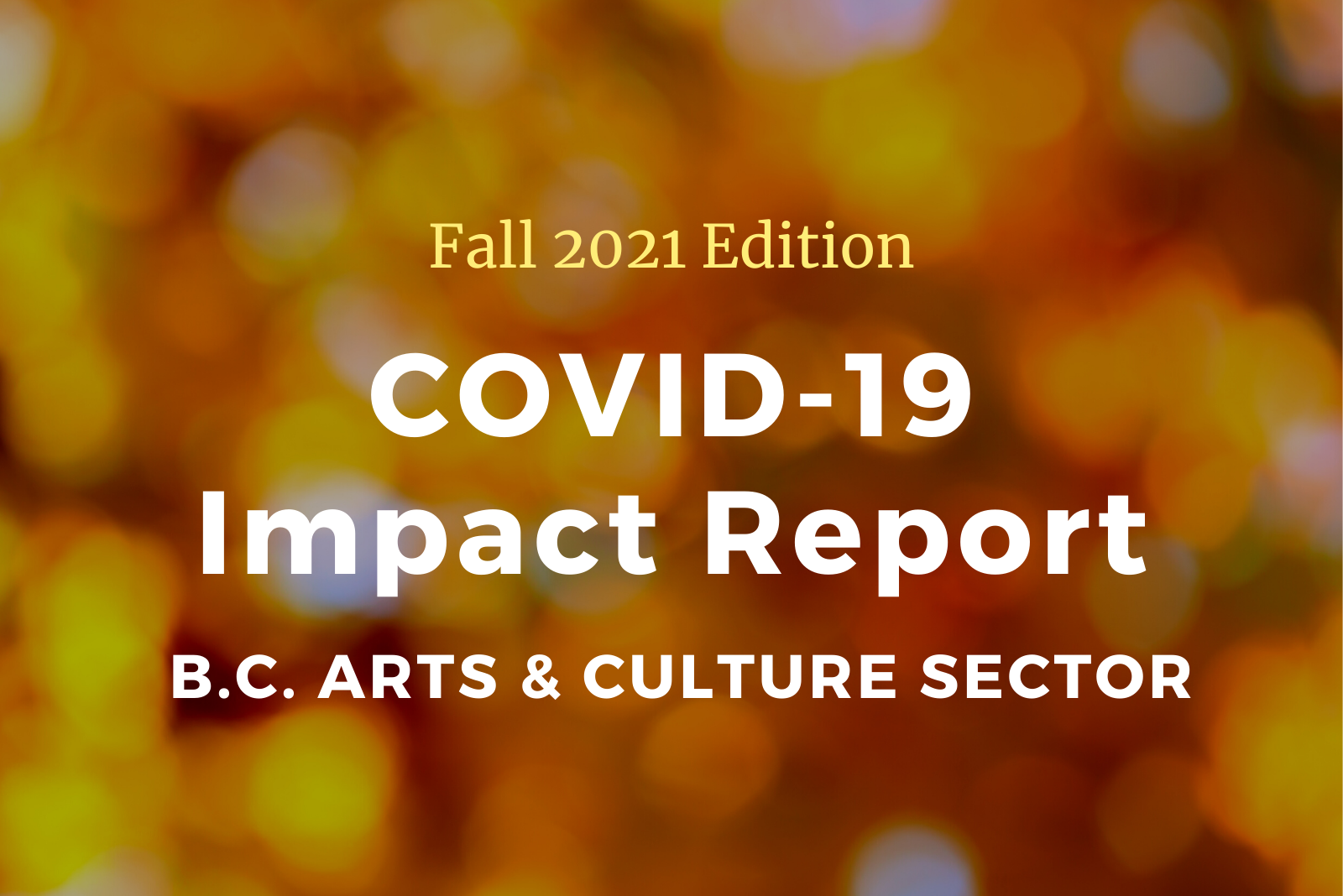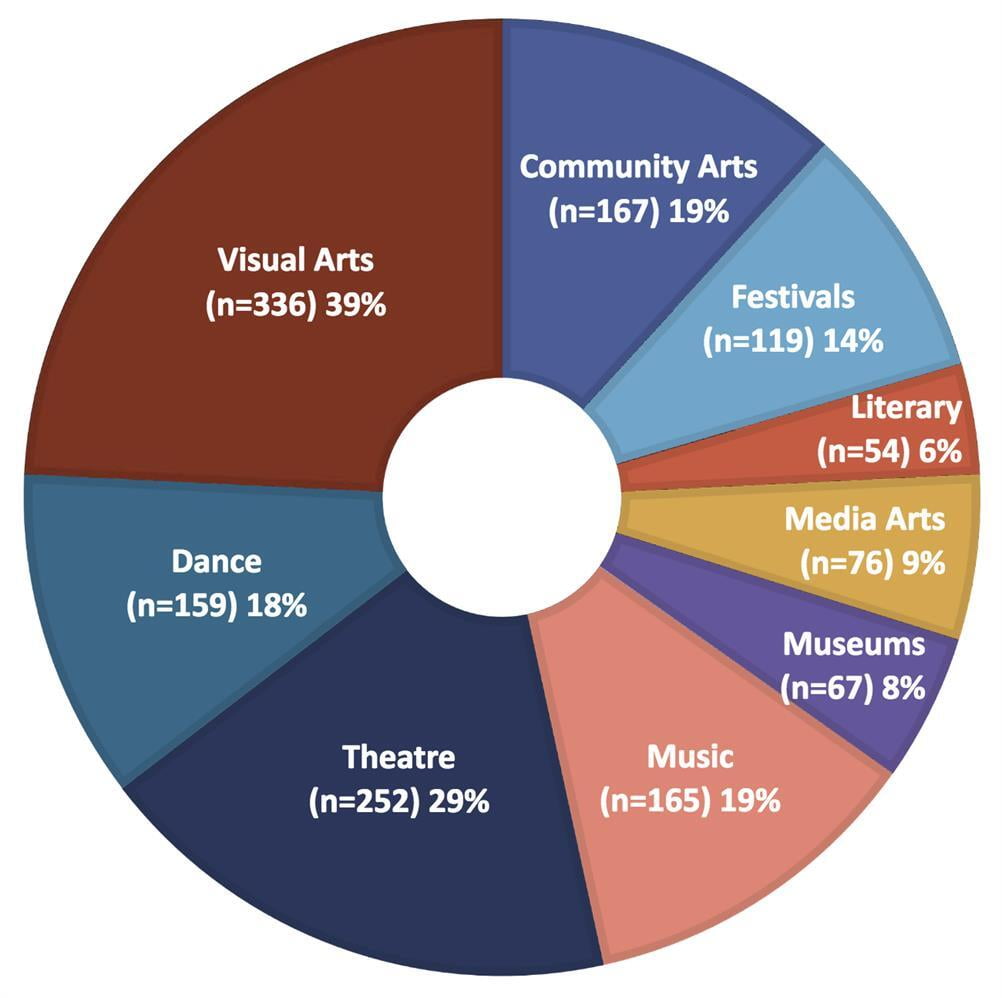COVID-19 B.C. Arts & Culture Sector Impact Survey
COVID-19 B.C. Arts & Culture Sector Impact Survey
Fall 2021 Sector Impact Report

This November, GVPTA and arts service organizations across the province invited individual artists, arts workers, and arts, culture and heritage organizations throughout British Columbia and across all disciplines to help convey a better understanding of where they are at now by completing the Fall 2021 edition of the COVID-19 B.C. Arts & Culture Impact Survey.
On November 30, GVPTA has released its fourth summary report on COVID-19's profound impact on the arts and culture sector across the province, based on survey responses collected between November 9 and 25, 2021.
As part of its data collection strategy, GVPTA has issued various iterations of the survey since March 2020, each evolving to understand the current and changing realities. The initial summary report was shared in June 2020, followed by others in December 2020 and April 2021. Read the backgrounder and past reports on this page below.
The survey was distributed through a network of arts service organizations, funders, and stakeholders across the province, social media, newsletters, and directly to previous survey respondents.
Aggregate data is shared with funders, researchers, and arts service organizations for regional, provincial, and national reporting and analysis.
Please note that, as with any survey, the data is only partial representation of the impact COVID-19 has had on the arts and culture sector in British Columbia.
View the highlights below of the Fall 2021 GVPTA COVID-19 Impact Report - B.C. Arts & Culture Sector, and click the red button below to download the PDF report.
Highlights from the Fall 2021 Report
About the Respondents
Of the 373 respondents, 55% were individual artists & arts workers, and the other 45% responded on behalf of an organization. Of the 205 responding as individuals, 51% identified solely as an artist, 17% solely an arts worker, and 32% as both artist and arts worker.
55% of the respondents were based in the Vancouver Coastal Health region, 15% from each Island Health and Fraser Health, 12% based in Interior Health region, and 3% from Northern Health.
The top five disciplines represented by respondents included: Theatre (49%), Music (29%), Visual Arts (27%), Community Arts (27%), and Multidisciplinary (20%)
Individuals
- One-third (36%) of individuals are working more in the arts now compared to six months ago, however more than half (56%) still work less than pre-pandemic levels. 9% are not working in the sector.
- If individuals had access to an unrestricted grant today, the top three priority areas selected by the most respondents include the costs to create or develop their art, professional development for their work in the arts, and to cover fixed costs (eg. rent, hydro).
- While artists have a consistent level of expectation working in the sector over the next two years, we see a dramatic decline in confidence with arts workers, which may result in a labour shortage.
- While increased stress or shortage of energy and general uncertainty continue to be the highest reported obstacles recently experienced by individuals (similar to the April report), when considering anticipated obstacles over the coming months, increased stress and maintaining sufficient cash flow are reported most frequently.
- Over three-quarters of individual respondents report vaccinations as a condition to help them feel safe in most work spaces. The nature of the work and space affects which other conditions (eg. masking, distancing) they would prioritize.
- More than one-quarter of organizations shared their financial position as being somewhat or very unstable.
- 6% of organizations that operate a facility indicate possible closure within 12 months. 2% have already closed or are in the process.
Compared to the previous four months, organizations expect a net increase in the number of staff, artists, contracts, and hours worked over thenext four months.
The most selected obstacles recently faced by organizations include: reduced sales income due to fewer patrons (76%), government regulations related to public health orders (76%); and uncertainty of government response to plan effectively (74%).
Although planning timelines were dramatically shortened due to the pandemic (45% planned at least one year in advance pre-pandemic, which dropped to 10% within the last year), 29% of organizations say they will have a longer planning cycle in 2023 compared to 2019.
If guidelines allow, 34% of respondents expect to return to 100% capacity by February. 38% don’t expect to return to full capacity until spring/summer of 2022. And 27% say it’s too difficult to predict.
If organizations had access to an unrestricted grant today, the top priority for 59% of respondents is to invest in creating and presenting arts programming.
Extended Health Benefits
- 43% of organizations offer extended health benefits to at least some of their employees, and 51% offer paid sick days.
- 57% of individuals have access to an extended health benefits plan; less than two-thirds indicate having access to mental health support.
Vaccines
- The majority (75%-85%) of respondents said the BC Proof of Vaccine program and BC Vaccine Card is positive for arts organizations, individuals, and the sector.
- 60% of organizations have an internal testing or vaccine policy in place, and of those, 84% say it’s had a positive impact on their organization.
Stress, Anxiety, and Optimism
- Stress and anxiety levels for both organizations and individuals continue to be high, and have had no significant change compared to the April report.
- Overall optimism that the arts and culture sector will recover from the impact of COVID-19 has increased compared to the April 2021 report, with nearly all organizations (97%) and the majority of individuals (84%) expressing confidence in recovery.
- Compared to April, self optimism about recovery from the effects of the pandemic by organizations declined slightly and stayed the same for individuals.
Fall 2021 Summary Report
Questions and Further Analysis
If you have questions about the report, or are seeking other segmented information, by discipline, region, demographics, or others, contact Executive Director Kenji Maeda with your specific request.





